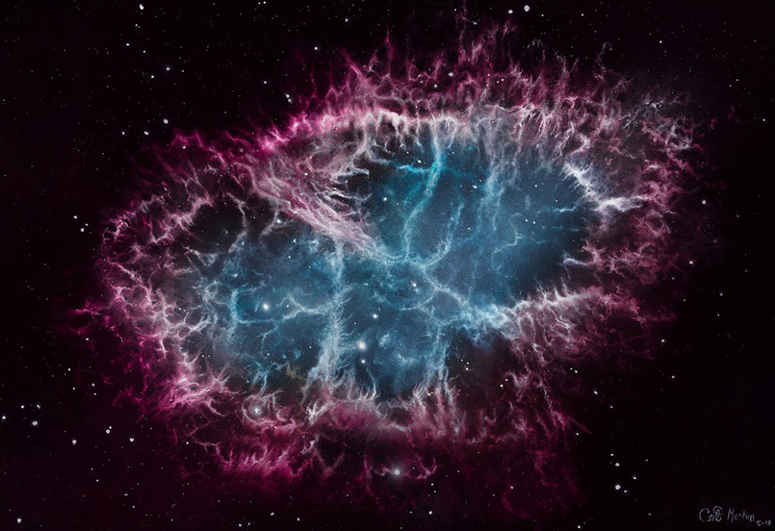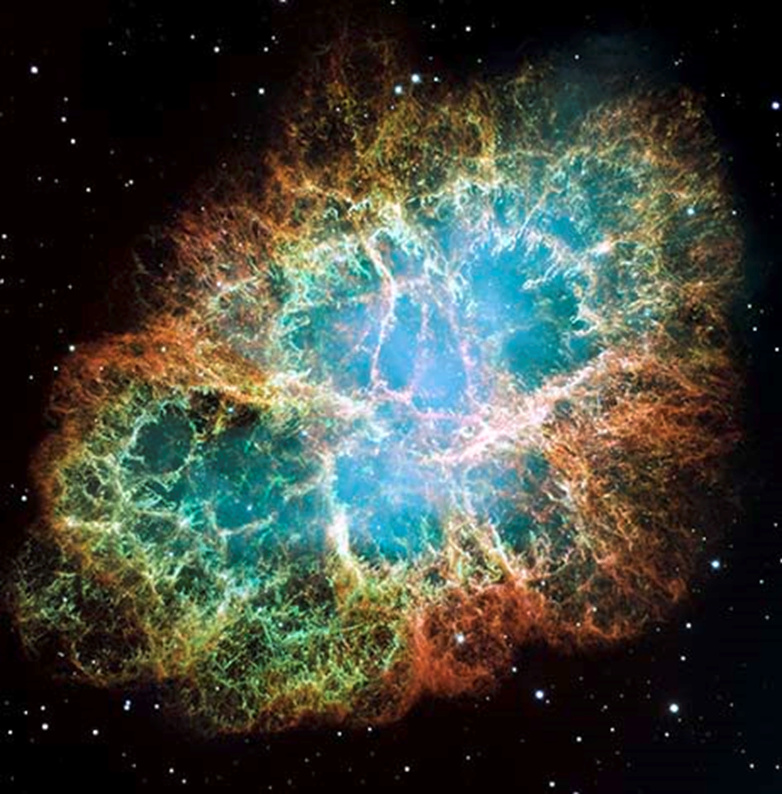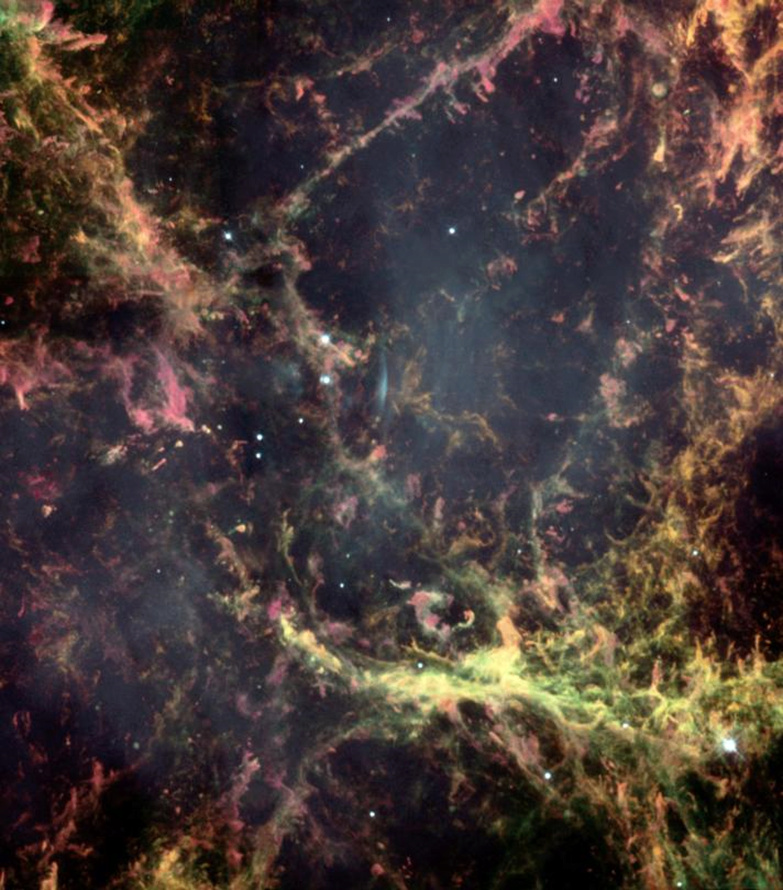Crab Nebula

The Crab Nebula, also known as Messier 1 (or according to the New General Catalog NGC 1952), is a supernova remnant and pulsating wind nebula in the constellation Taurus. John Bevis had noticed this nebula in 1731, and its discovered location matched historical records dating back to the Arabs, Chinese, Koreans, and Japanese of the location of a bright star that appeared in the year 1054. These records indicate that the star was so bright that it remained visible in daylight for 23 days, and at night for 653 days. There is some evidence to support what was said that the Native American Mimbres and Anasazi people noticed the brightness of the star and documented it in one of their drawings on the plateaus surrounding their villages.
The energy of this nebula, emitted in the form of The Crab Nebula is about 6,500 light-years from Earth. Its diameter is about 11 light-years and is expanding at a speed of about 1,500 kilometers per second.
At the center of the nebula is a neutron star, the Crab Pulsar, which emits pulsed radiation consisting of X-rays and gamma rays, and rotates at a speed of 30.2 revolutions per second. The Crab Nebula is the first celestial body known to have been a historical supernova explosion.
The Crab Nebula is a radiation source for studying the celestial bodies it obscures. In the 1950s and 1960s, the sun's corona was studied by monitoring radio waves emanating from the Crab Nebula as they passed through the corona. In 2003, the thickness of the atmosphere of the moon Titan - a satellite of Saturn - was measured as it was filtered by X-rays coming from the nebula.
Foundation

The origin of the nebula is consistent with the observations of Chinese astronomers and Muslim astronomers regarding the observation of the supernova MA 1054 in the year 1045. The first person to observe the Crab Nebula (in its nebular state) was John Bevis in 1731. Then it was rediscovered again by Charles Messier in 1758 when he was observing Guilty. Messier included it as his first classification in his work List of Nebulae and Star Clusters. In 1840, William Parson observed it from Bear Castle and called it the Crab Nebula because its shape resembled a cancer.
Historical records indicate the appearance of a new star that shines during the day. It was observed by Chinese and Arab astronomers, and its position in the sky was described identically by both parties. Given the distance between them, the daylight star observed by the Arabs and Chinese must have been a supernova that had exhausted its energy supplies from nuclear fusion and collapsed in on itself.
Current analysis of historical records suggests that the supernova that generated the Crab Nebula likely appeared in April or May. Its apparent magnitude rose to its highest value in July, between -7 and -4.5 (it was brighter than anything in the sky except the sun and moon). The supernova remained visible to the naked eye for two years after its first observation. The Crab Nebula thus became the first celestial body proven to have been created by a supernova explosion.
Physical properties
In visible light, the Crab Nebula appears to consist of a vast, elliptical, filament-shaped cluster surrounding a blue central region, about 4 arcminutes wide and 6 arcminutes long. It is believed that its three-dimensional shape will be spherical, elongated. The filaments are the remnants of the atmosphere of the exploding star's progenitor, and contain a high amount of helium and ionized hydrogen as well as oxygen, carbon, iron, nitrogen, neon and sulfur. The temperature of the filaments ranges between 11,000 and 18,000 Kelvin, and its density is about 1,300 molecules per cubic centimeter. In 1953, Joseph Shiklovsky proposed that the diffuse blue light region arose as a result of cyclotron radiation, which is the radiation resulting from the bending of the motion of electrons when they move at a speed equal to half the speed of light. This theory was confirmed three years later by observation. In 1960, he discovered that the source of the deviation of the path of electrons is a large magnetic field generated as a result of the presence of a neutron star in the center of the nebula.
The dimension
Although the Crab Nebula is an important focus of astronomers' discussions, how far away we are from it is still an open question. This is due to uncertainty in the methods of all methods used to calculate distance.
In 2008, consensus was found that the distance separating Earth from the Crab Nebula is 2.0 ± 0.5 thousand parsecs (6500 ± 1600 light-years). The Crab Nebula is currently expanding outward at a speed of 1,500 kilometers per hour. Many pictures of this nebula were taken over many years without discovering its slow expansion. The speed of expansion was determined by comparing the expansion angle with spectroscopic analysis. Several analytical methods were used in 1973 to calculate the distance from the nebula, eventually arriving at a result of 6,300 light-years.
Tracing the trace left by the expansion of the nebula matches the data about the emergence of the nebula in the year 1054. This means that its expansion speed has accelerated since the explosion occurred, and it is believed that this acceleration is the result of the pulsating energy feeding the nebula’s magnetic field.
Mass
Estimating the total mass of the nebula is important in order to estimate the mass of the supernova that generated the nebula. The total mass in the filament and the pulsar is estimated at about 4.6 ± 1.8 solar masses.
Helium-rich toruses
are one of the many components of nebulae. Helium-rich toruses can be seen in the east-west band intersecting the pulsar region. The hoop consists of 25% visible projectiles, and the proportion of helium is 95%. To date, no accepted explanation has been developed to explain the structure of the torus.
Central star

Image of a small region of the Crab Nebula showing the unstable Rayleigh-Tyler region taken by the Hubble Space Telescope.
There are two faint stars at the center of the Crab Nebula. One of them is the star responsible for the existence of the nebula. It was first identified in 1942 when Rudolf Minkowski observed an unusually large optical spectrum. In 1949, an area was found as a large source of radiation waves and X-rays in 1963, and it was identified as one of the brightest stars with gamma rays in the sky in 1967. It was discovered in 1968 that this star emits its radiation in a pulsed manner, making it the first pulsar discovered.
Pulsars are a large source of electromagnetic radiation, emitting many short, highly regular pulses per second. This emission was a source of great mystery when it was first discovered in 1967, and the team that first discovered it considered the source of the emission to be an advanced civilization present there. In any case, the discovery of the source of pulsating radiation in the core of the nebula was evidence that the pulsator was formed as a result of a supernova explosion.
The Crab Pulsar is thought to be 28 to 30 kilometers in diameter, and emits a pulse of radiation every 33 milliseconds. The wavelength of the pulse is along the electromagnetic spectrum, from radio waves to X-rays. Like all isolated pulsars, the rotation period gradually slows down. The deceleration of the pulsar's rotation period sometimes exhibits sharp changes, known as 'glitches', and this is thought to be caused by sudden recombination within the neutron star. The amount of energy generated by slowing down the pulsar's rotation is enormous. The energy of synchrotron radiation emanating from the Crab Nebula has a total luminosity of 75,000 times the luminosity of the Sun.
The high energy output from the pulsar creates a highly dynamic region at the center of the Crab Nebula. Astronomical objects within this region show rapid changes that extend over a time scale of only a few days, while changes in astronomical objects develop slowly, determined on a time scale extending over several years. The most dynamic changes in the nebula occur at the point where the pulsar's equatorial winds collide with the nebula's mass, forming what is known as a shock wave. The shape and position of these features change rapidly. Equatorial winds appear as thin beams that bend, shine, and then fade as they move away from the pulsar until they emerge from its main body.
Progenitor of the central star
A star that exploded as a supernova is referred to as a supernova progenitor. There are two types of stars that can explode as a supernova: white dwarfs and high-mass stars. The first type is a star that was a white dwarf with the mass of the Sun. It picked up additional matter from a neighboring star until it reached a critical mass, which is the Chandrasekhar limit, which led to its explosion. As for the second type, it is a star with a large mass that ran out of nuclear fuel so that the forces of gravity overcame its internal pressure, so it collapsed in on itself, reaching an exceptional temperature that allowed it to explode. The presence of the pulsar at the heart of the Crab Nebula proves that it formed at the center of the supernova collapse. White dwarfs do not produce pulsars.
The theoretical model of the supernova explosion suggests that the star that exploded to form the Crab Nebula was a massive star with a mass between 9 and 11 times the mass of the Sun. According to theory, a star with a mass less than 8 times the mass of the Sun cannot cause an explosion in the form of a supernova, but rather its end will be in the formation of a planetary nebula. As for stars with a mass greater than 12 solar masses, they produce a nebula with a chemical composition different from that of the Crab Nebula.
One of the biggest problems facing the study of the Crab Nebula is that the mass of the nebula along with the mass of the pulsar is much less than the mass predicted for the mass of the progenitor star, and the big question that remains unresolved is where the missing mass went. The mass of the nebula is estimated by measuring the total amount of light emitted, to calculate the mass of the nebula, and gives both the temperature and density of the nebula. Thus, estimates indicate that its mass ranges from 1 to 5 times the mass of the sun, and the acceptable value is considered to be 2-3 times the mass of the sun. The mass of a neutron star ranges between 1.4-2 times the mass of the Sun.
The most widely accepted theory to explain the Crab Nebula's mass loss is that a large proportion of the mass was removed shortly before the supernova explosion by fast stellar winds. This will form an envelope around the nebula, and despite attempts to detect this envelope using observations at different wavelengths, this envelope has not yet been discovered.
Transiting solar system bodies

Image of the pulsar. This image combines infrared radiation captured by Hubble (red) and X-rays captured by the Chandra X-ray Space Telescope (blue).
The Crab Nebula is located at an angle of 1.5 degrees from the path of the sun. This means that the moon and sometimes planets can pass through or obscure the nebula. Although the Sun does not obscure the nebula, its corona can pass in front of it. This transit and occultation is used to study the nebula and objects passing in front of it, by monitoring the change in radiation emitted by the nebula during the transit.
A lunar transit was used to determine the X-ray emission from the nebula. Before the use of satellites equipped with telescopes that measured X-rays, ground-based telescopes were used that were sensitive to X-rays but had low angular resolution. But when the moon crosses in front of the nebula, the position is very appropriate. Illumination changes can be used to map the X-ray emission with different “false” colors, each color representing low-energy X-rays, medium-energy X-rays and high-energy X-rays, each emanating from a specific location in the nebula. When the first X-rays emanating from the nebula were detected, the moon's occultation was used to accurately determine the source of the rays.
The sun's corona crosses in front of the nebula every year in June. Changes in radio waves received from the nebula are used to determine the density and composition of the corona. Preliminary observations have confirmed that the sun's corona extends outward more than previously expected, and current observations have confirmed that the corona's density is changing significantly.
It is rare for Saturn to cross the Crab Nebula. The last such transit was in 2003, while the previous transit was in 1296, and the next transit will occur in 2267. The Chandra X-ray space telescope was used to observe Saturn's moon Titan. He discovered that the shadow of Titan depicted by X-rays is larger than that of a solid body, due to the absorption of X-rays by its atmosphere. This observation was used to calculate the thickness of its atmosphere, and it turned out to be about 800 kilometers. The Chandra X-ray Space Telescope will not be able to observe Saturn's next transit because it will pass through the Van Allen radiation belt at that time.
Source : websites

